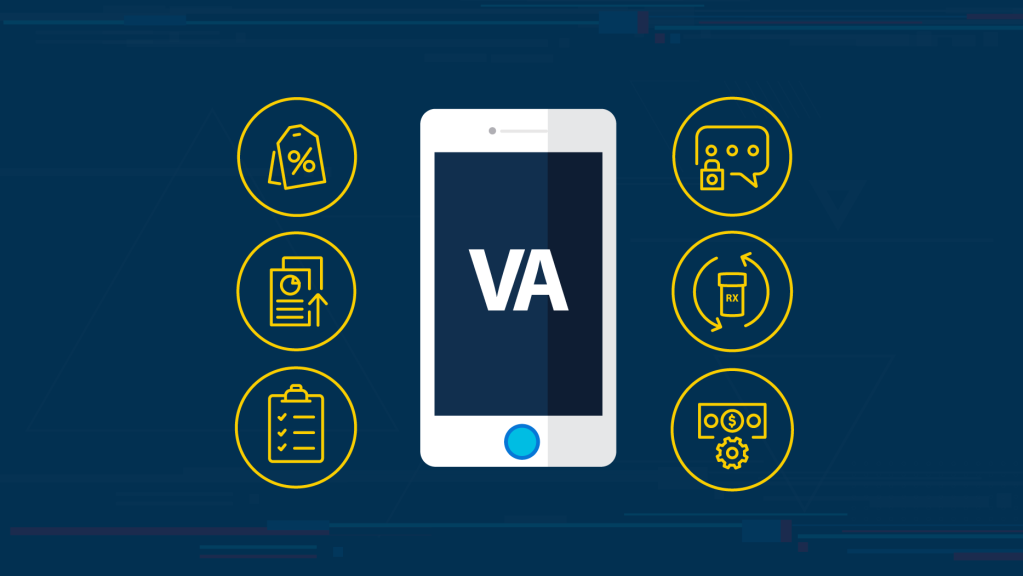Appears In
According to the 2021 All Employee Survey, the U.S. Department of Veterans Affairs (VA) supports a workforce of over 13,000 lesbian, gay, bisexual, and transgender employees, and an even larger and more diverse Veteran population. As part of Secretary Denis McDonough’s goal for VA to “align the Department’s policies and procedures with the President’s vision for a more inclusive government,” VA broadly implemented the option for its employees to add personal pronouns to their digital display names.
The technology solution lets staff easily add personal pronouns to their VA Microsoft O365 and Outlook digital display names without supervisor approval. Digital display names appear in employees’ emails, in virtual meetings, and while using other digital tools. This means when a VA employee participates in a digital forum, their personal pronouns are highly visible, appearing prominently next to the employee’s name. This allows all VA employees to clearly identify their team members by the correct pronoun. To date, more than 23,500 VA staff have already taken advantage of this feature. This self-service feature is not yet widely available across the Federal Government and private industry and helps to solidify VA as a leader in the field of inclusivity.
This is just one example of a strategic initiative designed to reflect the diversity of the Veteran population we serve. By building a more inclusive culture at VA, we can create an organization that offers its employees higher job satisfaction, lower turnover, higher productivity, and higher employee morale which in turn support a more agile organization that inspires creativity, problem-solving, and innovation. To ensure a welcoming environment for Veterans, we must foster fair and inclusive VA workplaces where the experiences and perspectives of our diverse employees are valued. The success of our mission depends on everyone being able to contribute their expertise, experience, talents, ideas, and perspectives. Deploying this solution, although relatively minor from a technical perspective, is a strong show of support for the foundation of VA’s organizational culture.
What are Personal Pronouns?
A personal pronoun is a pronoun used to refer to the speaker or those the speaker is speaking to or about. Correctly using personal pronouns is a way to show respect and cultivate an inclusive culture. Some personal pronouns include:
- He/him/his
- He/his/el
- He/they
- She/her/hers
- She/her/ella
- She/they
- They/them/theirs
- Ze/zir/zirs
- Ze/hir/hirs
Why Should Your Organization Promote the Adoption of Personal pronouns in Digital Display Names?
Adopting personal pronouns in display names helps organizations reflect the diversity of their workforce, show their support for colleagues, business partners, and customers, and ensure their organization is a welcoming, inclusive place for everyone. By referring to personal pronouns displayed in Microsoft 0365 and Outlook, organizations can help normalize their use and promote empathy and trust by making sure they are identifying individuals appropriately and not making assumptions based on names or appearances.
Most people think of sharing personal pronouns as a Lesbian, Gay, Bisexual, Transgender, and Queer or Questioning (LGBTQ+) issue. Still, it is possible to misgender people who are not part of the LGBTQ+ community, too — for example, incorrectly using “Mr.” for an “Alex” or “Sam” who identifies as a female. Sharing personal pronouns takes the assumptions and guesswork out of our interactions with everyone regarding gender. By sharing personal pronouns, we are demonstrating respect and helping to build empathy and trust for individuals, regardless of how they identify. As a result, all VA employees benefit from clear communication and a compassionate workplace.
An expanded understanding and recognition of individuals also enables VA to address inequity, health disparities, and barriers to access and opportunities. It supports the creation of an organization where all employees support the cultural transformation to a more inclusive, diverse, and equitable VA for all, especially those from underserved communities. At VA:
- Inclusion means that every individual who enters a VA facility feels safe, included, and valued. VA will treat all Veterans, employees, families, caregivers, survivors, and Service members with dignity, integrity, and respect.
- Diversity means that VA strives to leverage the strength and uniqueness that defines our Veteran and other beneficiary populations, our VA workforce, and our country. VA welcomes all Veterans and other beneficiaries and appreciates the differences, qualities, and attributes that make everyone unique.
- Equity means VA intentionally commits to consistent and systematic fairness, just and impartial treatment of all individuals and a just distribution of tools and resources to give everyone, including those who belong to marginalized and underserved communities.
How Did VA Implement Personal Pronouns in Display Names?
On January 26, Assistant Secretary for Information and Technology and Chief Information Officer Kurt DelBene approved using personal pronouns in VA digital display names. Immediately the VA Office of Information and Technology (OIT) personal pronoun team began collaborating with the VA LGBTQ+ Committee, Veterans Health Administration, and VA Central Office to create a new customer-centric process. Just 25 days later, the team delivered the personal pronoun feature pilot. The following month, VA launched an enterprise-wide capability.
OIT’s agile approach to product delivery was the key to the personal pronoun project’s success. VA’s approach sets it apart from others in the federal and industry space; It is a culture-based approach where one integrated team prioritizes collaboration with the business partner to improve customer service and the end-user experience. This modernized approach to product delivery allows VA to release functionality in smaller pieces, continuously incorporating feedback and resulting in more frequent customer enhancements. From the start, the OIT personal pronoun team was single-minded in their focus, developing a clear vision for the work, creating priority-driven roadmaps, and executing with excellence, rigor, and consistency at every level.
The VA OIT personal pronoun team initiated the project by socializing the project concept and gaining approval from executive leadership and governance boards. Then they coordinated with subject matter experts across VA to develop project requirements. Once requirements were established, they began work to update existing guidelines to allow employees to display pronouns in the display name field in the active directory. The next step was one of the most important, supervisory review and approval was eliminated from the process; VA employees now are empowered with a fully automated self-service feature that allows them to select the personal pronouns that best reflect their own individual unique personal identity. Next, the personal pronoun team worked to modify and streamline the process workflow to allow updates in as few steps as possible, making the process fast and user-friendly. Finally, after identifying methods to track these requests and gather data and metrics on the number of tickets submitted and completed, VA-wide guidance was issued to communicate the new feature was available to all.
The team’s ability to work in parallel and collaborate with others across the organization was critical to the timely launch of this initiative. Their support exemplifies an unwavering commitment to the VA workforce and an understanding that people are the core of VA operations. They understand that the success of our mission depends on all VA employees being able to contribute their expertise, experience, talents, ideas, and perspectives. The OIT Personal Pronoun team exemplifies the VA’s core value of respect by developing and delivering technology solutions that foster fair and inclusive VA workplaces where diverse employees are valued and encouraged to express themselves freely.
A Technical Roadmap for Personal Pronoun Implementation at Your Organization
The overall implementation of the capability at VA was planned in a phased approach. The first phase was a quick-reaction capability allowing any network user to request the addition of personal pronouns and update them to the digital display name with the assistance of the Enterprise Service Desk. The second phase was to automate the process and create a self-service capability for all users wishing to add or remove personal pronouns from their digital display name. Below is a recommended technical roadmap that can help your organization successfully add personal pronouns to digital display names.
Phase 1: Technical Update of Display Name to include Personal Pronouns
- Define Requirements
- Requirements were captured with the business team and technical teams to ensure the needs of the users were met and minimized any potential unintended use of the tool.Requirements include:
- Drop-down selection of personal pronouns
- Ability to select up to two sets of personal pronouns
- Ability to remove personal pronouns from display name
- Do not allow free form text
- Personal pronoun selection does not require approval
- Ability to track for reporting and metrics gathering purposes numbers of additions, removals etc.
- Dashboard for leadership to review metrics of personal pronoun update use
- Offer the user an email address to voice concerns or request additional pronouns be added to the drop-down selection lists
- Implement Updates in Work Order System and Access Management Toolkit
- Work order system team updates
- Pronoun drop-down selection
- Ticket creation
- Capture of reporting metrics for the leadership dashboard
- Access management team updates
- Drop-down selection of personal pronouns
- Ability for updates to other display name attributes
- Creation of updated display name and communication of the new display name via Microsoft Identity Manager to the active directory
- Provide access for Enterprise Service Desk representatives to access tool to make updates based on the work order system ticket input by the user
- Work order system team updates
- Perform Development Testing
- Both work order system and access management teams performed development testing in development environments
- Knowledge Article Development
- Flow capture
- Error handling
- Creation and publication of appropriate articles
- Perform End-to-End testing in All Environments
- End-to-End testing was performed by both work order system and access management teams in the following lower environments:
- Development
- Software Quality Assurance (SQA)
- Pre-production
- Production Release
- Ensure release to production for both work order system capability and access management capability
- Perform Production Testing
- Testing was completed with several volunteers
- Short-term Minimal Release
- Released to select user groups for verification
- Go-Live
Phase 2: Self-Service Personal Pronouns
- Define Requirements
- All requirements from Phase 1 remain
- Personal pronouns will be able to be updated directly by the user in a self-service manner
- Initiation of the self-service capability will be done through work order system tile for personal pronouns
- Continued support for leadership dashboard update to provide metrics regarding use of the service
- Implement Updates in Work Order System and Access Management Toolkit
- Work order system team updates
- Discontinue personal pronoun drop-down selection
- Discontinue ticket creation
- Execute access management personal pronoun self-service update when personal pronoun tile is selected
- Accept direct update from access management with the metrics regarding the user self-service selections to populate the leadership dashboard
- Capture of reporting metrics for leadership dashboard
- Access management team updates
- Implement executable personal pronoun update capability
- Build functionality to notify Service Now of the updates for metric gathering
- Ensure single-sign-on functionality when user accesses personal pronoun self-service
- Creation of updated display name and communicate the new display name via Microsoft Identity Manager to active directory
- Development Testing
- Both work order system and access management teams performed development testing in development environments
- Knowledge Article Development
- Flow capture
- Error handling
- Creation and publication of appropriate articles
- Perform End-to-End Testing in All Environments
- End-to-end testing was performed by both work order system and access management teams in the following lower environments:
- Development
- SQA
- Pre-production
- End-to-end testing was performed by both work order system and access management teams in the following lower environments:
- Production Release
- Ensure release to production for both work order system capability and access management capability
- Perform Production Testing
- Testing was completed with several volunteers
- Go-Live
Simple IT Solutions, Big Organizational and End User Impacts
IT solutions can make significant cultural impacts and help organizations increase understanding and eliminate disparities for their employees, business partners, and customers. The personal pronoun project is just one example of how agile processes can increase the speed of IT solution development and delivery to improve customer satisfaction and the overall user experience. Implementing personal pronouns in digital display names highlights the VA’s commitment to representing the diverse group of Veterans it serves and creating a more supportive workplace for its existing employees — as well as a more attractive place for future talent to work. Enabling pronouns for VA employees and Veterans helps set the stage for other federal agencies and workplaces to follow suit with their diversity, equity, and inclusion efforts.
Our commitment to digital and IT transformation is shaped by our daily dedication to customer service and the close collaboration of our workforce, managers, and leaders. Ready to join us in improving Veterans’ care? Check out all current information and technology career opportunities on DigitalVA. You can also contact VA’s Office of the Chief Human Capital Officer at 512-326-6600, Monday thru Friday, 7 a.m. to 5 p.m. CST or by submitting a resume to VACareers@va.gov.
Topics in this story
In this article








